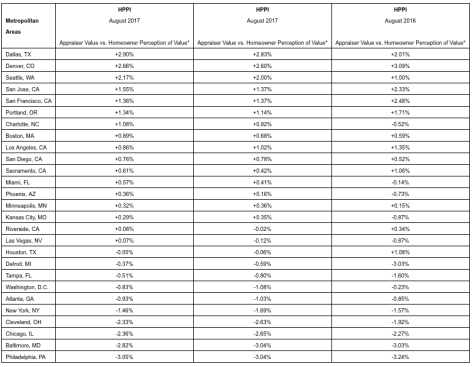Appraisals continued to lag homeowner expectations in August, although the difference between appraiser and owner opinions narrowed, according to Quicken Loans’ National Home Price Perception Index (HPPI), out Tuesday.
The HPPI showed that appraised values were 1.35% lower than home owners’ expectations in August. This is compared to July when there was a 1.55% difference.
Home values ticked up 0.19% in August, according the Quicken Loans’ National Home Value Index. When viewed annually, values rose an average of 2.64% compared to August 2016.
Regionally, value perceptions vary widely across the country, from home values being 3% higher than home owners estimated in the West, to 3% lower than expected in the Midwest and Northeast. A 3% difference may seem small, but depending on the local market, it could make a significant impact on value. For instance, a homeowner in Denver may have upwards of $11,000 in additional equity they can access for home improvements or loan consolidation.
“One of the biggest lessons from the HPPI, is highlighting how regionalized real estate is,” said Bill Banfield, Quicken Loans executive vp of Capital Markets. “Home owners who have a better understanding of their local housing market can make more informed decisions about their home. After all, their house is not just where they live, but one of their bigger assets.”
Home values rose in Auguest rose at the slowest pace in 2017. The HVI, the only measure of home value changes based solely on appraisals, reported that appraisals posted stronger growth when viewed at a year-over-year basis, increasing 2.64%. At a regional level, there was a slight downturn in home values in the South and East – dipping 0.52% and 0.58%, respectively. The Midwest and West regions each had rising appraisal values, increasing 0.16% and 1.34%.
“As the sun sets on the summer, some of the intense competition for housing also winds down,” said Banfield. “It’s important to focus on the annual numbers with the HVI. While there can be some monthly variations in the data, especially as seasons start to change, the annual numbers show healthy growth across the country.”



